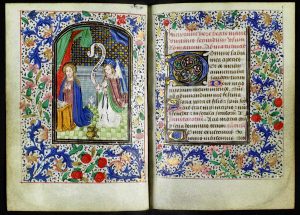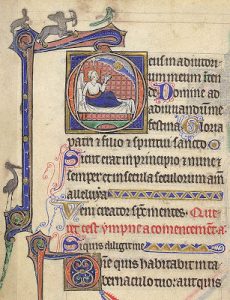Christian Identity
Summary
This week’s lecture covered the time period between 0-1450’s. One major change in history was the conversion to Christianity as the Roman Empire had fallen. It was after the establishment of the church in Europe, where artists and illuminists had truly showed their art. During this era, it was clear to see that religion had taken its part as inspiration for the creation of codices and books. This had shown clearly through various well known artifacts such as, The Book of Hours, Cuthbert Gospel, and the Celtic Psalter.

The Book of Hours, Folios 48v-49r: The Annunciation (Matins)
What was also interesting were the elements of typography and printing that we still associate with today. The function of Gutenberg’s printing press works similarly to the forms of printing technologies we use today. I was also quite intrigued by efforts put into the research and discoveries of new writing surfaces and materials. It brought me to think: how in the world they came up with the solution to produce better qualities of paper by using the skins of animals?
Research
This week, I was tasked to research “culture” for this time period. I focused my research on the the influences of Christianity during the middle ages. After diving into the vast subject of this religion, it had clearly stated its importance in the development of the Western Culture. Christianity had heavily influenced the way of life of many during this era as Pope held dominant power over Western Europe.

Saint Gregory by Zurbaran
Church leaders played the role as government leaders and was responsible for providing salvation to their people (A. Irwin, M. Watts). In other words, they were responsible for guiding their people towards the Lord’s heavenly kingdom waiting for them after death. This was to be achieved by doing good deeds, obeying the commandments and participating in the holy sacraments. This nature of living to please their God, and for his forgiveness for eternal rest in heaven had shaped the cultural society in which we view Europe during the middle ages. Rituals and habits had been part of their daily and weekly routines including: singing, chanting and reciting prayers written in the devotional prayer book, The Book of Hours.

A man wakes and greets the sun, from the beginning of Prime in a 13th-century English Book of Hours, BL Egerton 1151
The church frowned upon superstitions and other beliefs, and encouraged the hindrance of culture (S. Newman). As Newman discusses in his article Culture in the Middle Ages, “the church feared that if the people were to gain more knowledge and education, the more likely they were to question their beliefs”(12). This suggests that the church had held many restrictions to the population of western Europe. In other words, in comparison to the cultural development of other time periods, this had limited their cultural growth.
Sources:
https://www.britannica.com/topic/history-of-Europe/The-Middle-Ages
http://www.csis.pace.edu/grendel/projs2c/middle.htmlhttps://www.christianitytoday.com/history/issues/issue-49/everyday-faith-in-middle-ages-christian-history-interview.html
http://www.medieval-life-and-times.info/medieval-religion/
http://www.learner.org/interactives/middleages/religion.html
http://www.thefinertimes.com/Middle-Ages/christianity-in-the-middle-ages.html
https://en.wikipedia.org/wiki/Francisco_de_Zurbar%C3%A1n